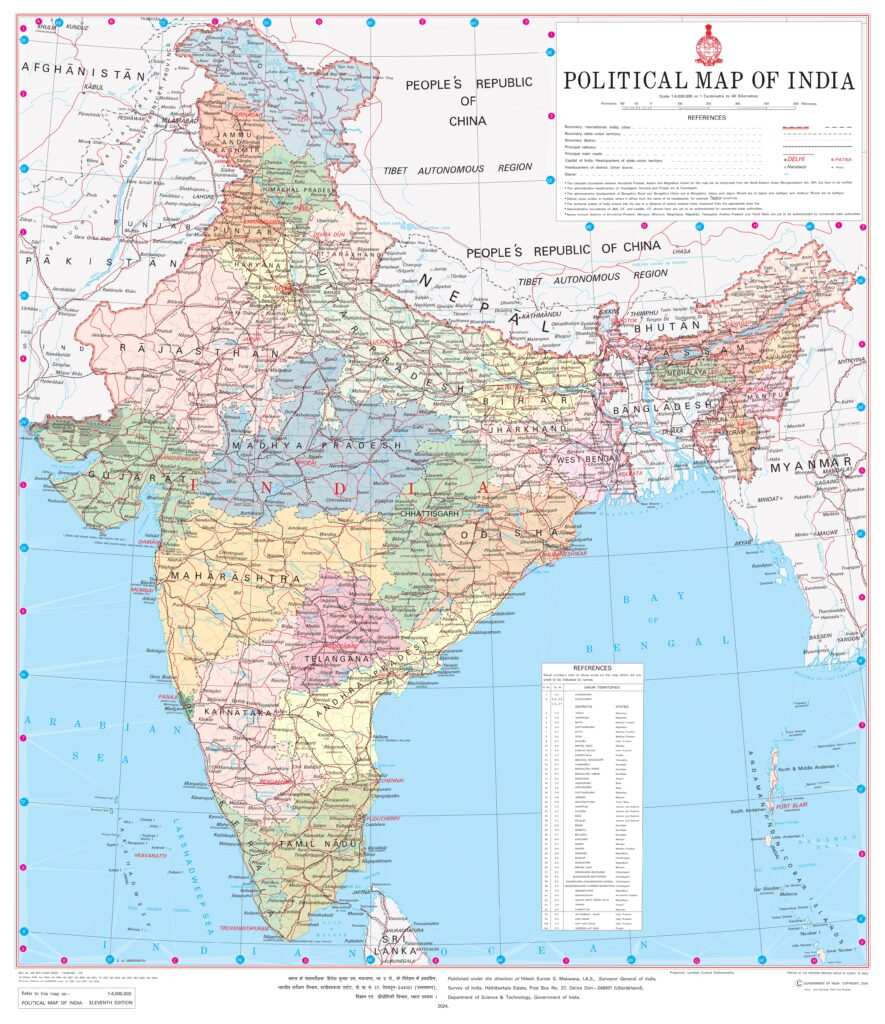Table of Contents
Introduction: First Schedule of the Constitution of India
The First Schedule of the Indian Constitution provides a detailed list of the states and union territories of India, along with their respective territorial definitions. This schedule is essential for understanding the geographical boundaries and political subdivisions of the country.
1st Schedule of the Constitution of India
- Structure and Content:
- The First Schedule is divided into two parts:
- Part I lists all the states.
- Part II lists all the union territories.
- Each entry specifies the territories included in each state or union territory, often with references to specific legislative acts that have defined or modified these boundaries over time.
- The First Schedule is divided into two parts:
Part I States

- Andhra Pradesh:
- Includes territories from various legislative acts, notably the Andhra State Act of 1953, the States Reorganisation Act of 1956, and the Andhra Pradesh Reorganisation Act of 2014, which created Telangana.
- Assam:
- It comprised territories from the former provinces of Assam, Khasi States, and Assam Tribal Areas. Exclusions are due to several boundary reorganization acts, including the creation of Nagaland and parts affected by the North-Eastern Areas Reorganisation Act, 1971.
- Bihar:
- Defined by territories from the former Province of Bihar and various reorganization acts. The Bihar Reorganisation Act of 2000 resulted in the creation of Jharkhand, excluding those territories from Bihar.
- Gujarat:
- Formed by the Bombay Reorganisation Act of 1960, separating it from Maharashtra.
- Kerala:
- Defined by territories specified in the States Reorganisation Act of 1956.
- Madhya Pradesh:
- Includes territories from the States Reorganisation Act of 1956. The Madhya Pradesh Reorganisation Act of 2000 carved out Chhattisgarh, thus excluding those areas from Madhya Pradesh.
- Tamil Nadu:
- Comprised of territories from the former Province of Madras and subsequent legislative acts, including the States Reorganisation Act of 1956.
- Maharashtra:
- Defined by the States Reorganisation Act of 1956 and further modified by the Bombay Reorganisation Act of 1960.
- Karnataka:
- Created from the States Reorganisation Act of 1956 and includes territories modified by the Andhra Pradesh and Mysore (Transfer of Territory) Act, of 1968.
- Odisha:
- Consists of territories from the former Province of Orissa.
- Punjab:
- Defined by the States Reorganisation Act of 1956 and modified by the Punjab Reorganisation Act of 1966, which also created Haryana.
- Rajasthan:
- Formed from territories specified in the States Reorganisation Act of 1956 and modified by subsequent acts.
- Uttar Pradesh:
- Comprises territories from the former United Provinces and is modified by various boundary acts. The Uttar Pradesh Reorganisation Act of 2000 created Uttarakhand, excluding those areas from Uttar Pradesh.
- West Bengal:
- Includes territories from the former Province of West Bengal and territories from the Chandernagore Merger Act, of 1954.
- Nagaland:
- Formed by the State of Nagaland Act of 1962.
- Haryana:
- Created by the Punjab Reorganisation Act of 1966.
- Himachal Pradesh:
- Includes territories administered as Chief Commissioners’ Provinces before independence and areas from the Punjab Reorganisation Act of 1966.
- Manipur:
- Consists of territories that were administered as a Chief Commissioner’s Province before independence.
- Tripura:
- Comprises territories administered as a Chief Commissioner’s Province before independence and territories modified by the Constitution (One-Hundredth Amendment) Act, 2015.
- Meghalaya:
- Formed by the North-Eastern Areas Reorganisation Act, 1971.
- Sikkim:
- Incorporated into India by the Constitution (Thirty-sixth Amendment) Act, 1975.
- Mizoram:
- Formed by the North-Eastern Areas Reorganisation Act, 1971.
- Arunachal Pradesh:
- Created by the North-Eastern Areas Reorganisation Act, 1971.
- Goa:
- Territories specified by the Goa, Daman and Diu Reorganisation Act, 1987.
- Chhattisgarh:
- Carved out from Madhya Pradesh by the Madhya Pradesh Reorganisation Act, 2000.
- Uttarakhand:
- Formed from Uttar Pradesh by the Uttar Pradesh Reorganisation Act, of 2000.
- Jharkhand:
- Created from Bihar by the Bihar Reorganisation Act, 2000.
- Telangana:
- Formed from Andhra Pradesh by the Andhra Pradesh Reorganisation Act, 2014.
Related Article:
Part II Union Territories
- Delhi:
- The territory of the Chief Commissioner’s Province of Delhi before the Constitution.
- Andaman and Nicobar Islands:
- Territories from the Chief Commissioner’s Province of the Andaman and Nicobar Islands.
- Lakshadweep:
- Defined by the States Reorganisation Act of 1956.
- Dadra and Nagar Haveli and Daman and Diu:
- Territories from the Free Dadra and Nagar Haveli and the Goa, Daman and Diu Reorganisation Act, 1987.
- Puducherry:
- Comprises former French establishments in India (Pondicherry, Karikal, Mahe, and Yanam).
- Chandigarh:
- Defined by the Punjab Reorganisation Act of 1966.
- Jammu and Kashmir:
- Territories specified by the Jammu and Kashmir Reorganisation Act, 2019.
- Ladakh:
- Created from the Jammu and Kashmir Reorganisation Act, 2019.
Constitution of India UPSC MCQ
will be uploaded soon.

